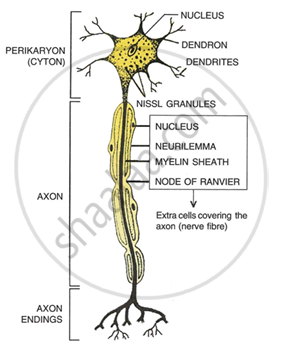Advertisements
Advertisements
Question
The diagram given below shows the internal structure of a spinal cord depicting a phenomenon. Study the diagram and answer the following questions.
 |
- Name the phenomenon shown in the figure and define the same.
- Identify the parts labelled as 1 and 2. Write one functional difference between these two.
- Name the bony protective covering and the membranous protective covering of the spinal cord.
- Label the guidelines 3 and 4.
- How is the labelled part 3 different from part 4 with respect to its composition (part of neuron)?
- Give the technical term for the point of contact between the two nerve cells.
- Name the fluid filled inside the central canal of spinal cord.
- Name the term used for a small gap between two neurons.
- Give one example of a neurotransmitter.
- Draw a neat diagram of a nerve cell and label the parts: Perikaryon, Node of Ranvier, Myelin sheath and Axon terminals.
Solution
- Reflex action: It is an automatic/quick/immediate, involuntary action in the body brought about by a stimulus.
-
- Sensory neuron: The neuron in the spinal cord receives nerve impulses via its axon/terminal ends, which connect to receptor cells.
- Motor neuron: It transmits impulses from the association neuron in the CNS to the effector organ (muscle or gland).
- The vertebral column protects the spinal cord, while the meninges (dura mater, arachnoid mater, and pia mater) offer membrane protection.
- Part 3: Gray Matter,
Part 4: White Matter - Gray matter is made up of cell bodies (cytons), dendrites, and neutron synapses. White matter is made up of axons that connect nerve cells in gray matter.
- Synapse
- Cerebrospinal Fluid
- Synapse
- Acetylcholine

RELATED QUESTIONS
How are involuntary actions and reflex actions different from each other?
When you smell a favourite food your mouth begins to water (that is, you secrete saliva). Write down what is the example of the smell of the food?
Which of the following helps in maintaining posture and balance of the human body?
Which of the following are cerebral reflexes?
(i) a person pulls away his hand on touching a hot object
(ii) a person spits out immediately when a fly enters his mouth while talking
(iii) A person walking bare foot lifts his foot at once on stepping on to a nail
(iv) A person's pupil contracts at once in the presence of bright light
(a) (i) and (ii) (b) (ii) and (iii) (c) (iii) and (iv) (d) (ii) and (iv)
Your are driving your bicycle at a fast speed. Suddenly, a small boy comes in front of your cycle and, without wasting any time in thinking, you immediately apply the brakes and accident is avoided. What name is given to such an action?
State whether the following is simple reflex, conditioned reflex or neither of the two.
Knitting without looking
State whether the following is
Salivation when food is put in the mouth.
Mention, if the following statement is True or False
Reflex action is a unit of nervous action
Give an example for conditioned reflexes.
State whether the following is simple reflex, conditioned reflex or neither of the two.
Sneezing
